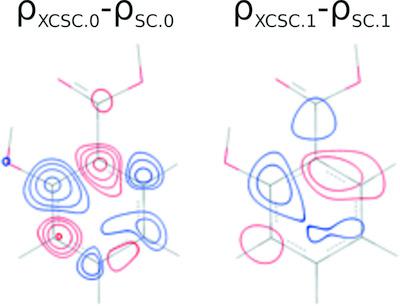当前位置:
X-MOL 学术
›
Acta Crystallogr. A Found. Adv.
›
论文详情
Our official English website, www.x-mol.net, welcomes your
feedback! (Note: you will need to create a separate account there.)
X-ray constrained spin-coupled technique: theoretical details and further assessment of the method
Acta Crystallographica Section A: Foundations and Advances ( IF 1.9 ) Pub Date : 2019-09-24 , DOI: 10.1107/s2053273319011021 Alessandro Genoni , Giovanni Macetti , Davide Franchini , Stefano Pieraccini , Maurizio Sironi
Acta Crystallographica Section A: Foundations and Advances ( IF 1.9 ) Pub Date : 2019-09-24 , DOI: 10.1107/s2053273319011021 Alessandro Genoni , Giovanni Macetti , Davide Franchini , Stefano Pieraccini , Maurizio Sironi

|
One of the well-established methods of modern quantum crystallography is undoubtedly the X-ray constrained wavefunction (XCW) approach, a technique that enables the determination of wavefunctions which not only minimize the energy of the system under examination, but also reproduce experimental X-ray diffraction data within the limit of the experimental errors. Initially proposed in the framework of the Hartree–Fock method, the strategy has been gradually extended to other techniques of quantum chemistry, but always remaining limited to a single-determinant ansatz for the wavefunction to extract. This limitation has been recently overcome through the development of the novel X-ray constrained spin-coupled (XCSC) approach [Genoni et al. (2018). Chem. Eur. J. 24 , 15507–15511] which merges the XCW philosophy with the traditional spin-coupled strategy of valence bond theory. The main advantage of this new technique is the possibility of extracting traditional chemical descriptors (e.g. resonance structure weights) compatible with the experimental diffraction measurements, without the need to introduce information a priori or perform analyses a posteriori . This paper provides a detailed theoretical derivation of the fundamental equations at the basis of the XCSC method and also introduces a further advancement of its original version, mainly consisting in the use of molecular orbitals resulting from XCW calculations at the Hartree–Fock level to describe the inactive electrons in the XCSC computations. Furthermore, extensive test calculations, which have been performed by exploiting high-resolution X-ray diffraction data for salicylic acid and by adopting different basis sets, are presented and discussed. The computational tests have shown that the new technique does not suffer from particular convergence problems. Moreover, all the XCSC calculations provided resonance structure weights, spin-coupled orbitals and global electron densities slightly different from those resulting from the corresponding unconstrained computations. These discrepancies can be ascribed to the capability of the novel strategy to capture the information intrinsically contained in the experimental data used as external constraints.
中文翻译:

X 射线约束自旋耦合技术:理论细节和该方法的进一步评估
现代量子晶体学的成熟方法之一无疑是 X 射线约束波函数 (XCW) 方法,这种技术能够确定波函数,不仅可以最小化所检查系统的能量,还可以重现实验 X-射线衍射数据在实验误差范围内。该策略最初是在 Hartree-Fock 方法的框架中提出的,现已逐渐扩展到量子化学的其他技术,但始终仅限于单行列式安萨兹 用于提取波函数。最近通过开发新型 X 射线约束自旋耦合 (XCSC) 方法 [Genoni等人。 (2018)。化学。欧元。J。 24 ,15507–15511]它将XCW哲学与价键理论的传统自旋耦合策略融合在一起。这项新技术的主要优点是可以提取传统的化学描述符(例如 共振结构权重)与实验衍射测量兼容,无需引入信息先验 或进行分析后验的 。本文在 XCSC 方法的基础上对基本方程进行了详细的理论推导,并介绍了其原始版本的进一步改进,主要包括使用 Hartree-Fock 级别的 XCW 计算得出的分子轨道来描述XCSC 计算中的不活跃电子。此外,还介绍并讨论了通过利用水杨酸的高分辨率 X 射线衍射数据并采用不同的基组进行的广泛的测试计算。计算测试表明,新技术不会遇到特定的收敛问题。此外,所有 XCSC 计算提供的共振结构权重、自旋耦合轨道和全局电子密度与相应的无约束计算得出的结果略有不同。这些差异可以归因于新策略捕获用作外部约束的实验数据中固有信息的能力。
更新日期:2019-09-24
中文翻译:

X 射线约束自旋耦合技术:理论细节和该方法的进一步评估
现代量子晶体学的成熟方法之一无疑是 X 射线约束波函数 (XCW) 方法,这种技术能够确定波函数,不仅可以最小化所检查系统的能量,还可以重现实验 X-射线衍射数据在实验误差范围内。该策略最初是在 Hartree-Fock 方法的框架中提出的,现已逐渐扩展到量子化学的其他技术,但始终仅限于单行列式











































 京公网安备 11010802027423号
京公网安备 11010802027423号